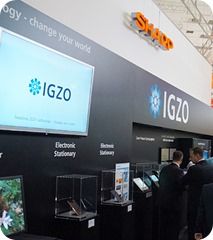 The power used by a screen in a laptop is becoming a major issue. As other components in laptops reduce their power, the percentage of total system power used by the screen and backlight is growing. 20-30% average is common but if you’re just reading a static page, the backlight could account for up to 50%. Come Haswell, that could jump to 70% or more in quiet-state operations. Advances in battery technology aren’t forthcoming so anything to get rid of those LED backlights is going to be worth taking a close look at. IGZO (Indium, Gallium, Zinc Oxide) technology could be one of the few answers.
The power used by a screen in a laptop is becoming a major issue. As other components in laptops reduce their power, the percentage of total system power used by the screen and backlight is growing. 20-30% average is common but if you’re just reading a static page, the backlight could account for up to 50%. Come Haswell, that could jump to 70% or more in quiet-state operations. Advances in battery technology aren’t forthcoming so anything to get rid of those LED backlights is going to be worth taking a close look at. IGZO (Indium, Gallium, Zinc Oxide) technology could be one of the few answers.
In short it’s a new type of screen backplane onto which traditional LCD or even OLED can be produced and combined with a new backplane foundation or substrate like Corning Willow Glass it could result in ‘roll-to-roll’ printing.
Cheaper production costs, larger screens, flexible backplanes, higher pixel densities, narrower bezel, less backlight loss, potential for OLED and lower overall power usage means there’s a big list of advantages.
The rumor is that Intel are working with Sharp, a producer (and possible Patent holder?) of IGZO panels to get these into Ultrabooks. A rumor that Intel will buy a 5% share in Sharp has been denied.
Sharp already have a prototype 13.5 inch 3840×2160 display with White OLEDs and a production 10 inch display with 2560×1660 resolution.
We’ll stay tuned to ‘IGZO’ and bring you reports of real-world power savings as we find them.
Sources:
Sharp, Sharp, Yahoo/Reuters, Marketwatch, SeekingAlpha, Toms Hardware, ieee











On the topic of IGZO patents.
I believe there are two competing implementations. There is Sharp/Japan Semiconductor Energy Laboratory (Made by Sharp I think), and Japan Science and Technology Agencies’s (Licensed to Samsung??? <Why not a Japanese company idk).
IGZO is very exciting stuff. We haven't seen such a large drop in display panel power consumption for a long time.
Hope that 10″ screen goes into 10″ Haswell notebooks.
Or manufactures will then just start building thinner machines with even smaller batteries & we are still stuck at 5hrs.
I sure hope not. This whole thin is better is getting annoying. They’re making notebooks thinner yet the footprints are sometimes larger and battery life isn’t that great. Also, I don’t like companies resorting to mini-ports. If a notebook has mini-ports then it wasn’t designed well enough or just plain too thin.
I couldn’t agree more with you lipile & Joe! It’s about damn time Intel gives us back all day ACTUAL USAGE battery life. All day battery life == requirement; after that make it as thin and light as possible but thin and light first and battery life second is getting pretty old.
Mobility enthusiasts haven’t even had a choice since the Ultrabook has launched. As far as I can tell the Ultrabook campaign was about taking away choice and locking in and trying to justify higher profit margins.
Adam